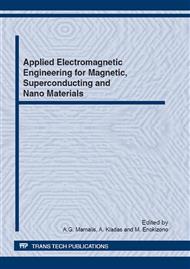p.281
p.287
p.293
p.301
p.307
p.313
p.319
p.325
p.331
High Efficiency Permanent Magnet Wheel Motor Design for Light Electric Vehicle Applications
Abstract:
Permanent magnet synchronous machines with non-overlapping concentrated fractional-slot windings present certain improved electrical characteristics compared to full pitch windings configurations. This paper describes the design process and construction of two 10-pole permanent magnet synchronous motors, featuring full-pitch and fractional-pitch windings. The paper compares these two configurations in terms of performance and efficiency. Both motors have been designed for direct-drive applications with low speed and high efficiency capability and are intended to be used as a traction drive in an electric prototype vehicle. The proposed motors have external rotor configuration with surface mounted NdFeB magnets. The electromagnetic characteristics and performance are computed and analyzed by means of finite elements analysis. These results are finally compared with the experimental measurements on respective prototypes.
Info:
Periodical:
Pages:
313-318
Citation:
Online since:
June 2012
Price:
Сopyright:
© 2012 Trans Tech Publications Ltd. All Rights Reserved
Share:
Citation:


